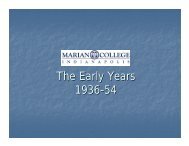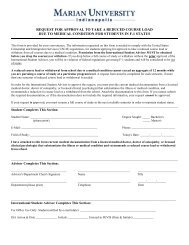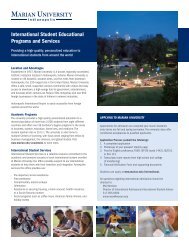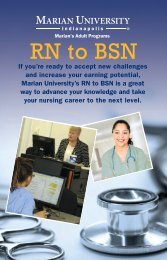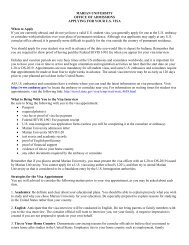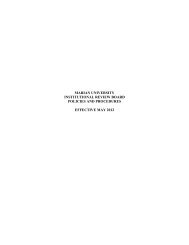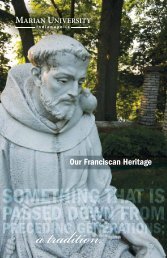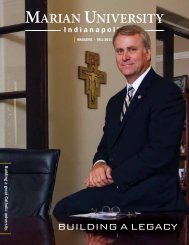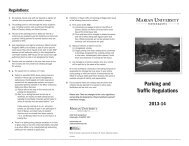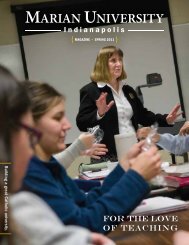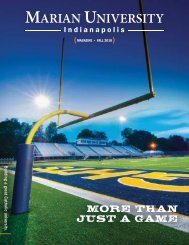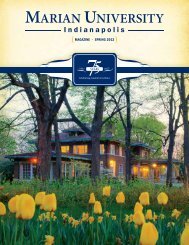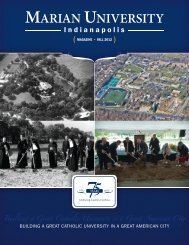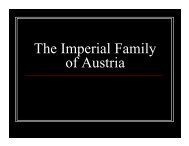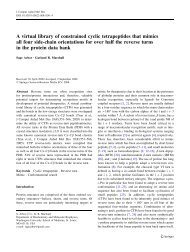2009-11 Marian University Course Catalog, fall 2010 edition
2009-11 Marian University Course Catalog, fall 2010 edition
2009-11 Marian University Course Catalog, fall 2010 edition
You also want an ePaper? Increase the reach of your titles
YUMPU automatically turns print PDFs into web optimized ePapers that Google loves.
German-Catholic residents of southern Indiana. Soon, the<br />
new congregation started teacher-training classes to prepare<br />
its members for teaching in its schools.<br />
This teacher-training program, eventually called St. Francis<br />
Normal, was established long before Indiana adopted its first<br />
tax-supported normal school for the preparation of teachers.<br />
St. Francis Normal was accredited by the Indiana State Board<br />
of Education in 1910. In 1936, the normal school merged with<br />
Immaculate Conception Junior College, founded in 1924, to<br />
become <strong>Marian</strong> College, a four-year institution open to both<br />
Sisters and lay women. The following year, under the<br />
direction of its founder Mother M. Clarissa Dillhoff, the<br />
college moved to Indianapolis after securing a state charter<br />
and purchasing the James A. Allison estate.<br />
When the college for Catholic women opened in the <strong>fall</strong> of<br />
1937, a staff of 16 welcomed 24 full-time women students<br />
and a larger number of part-time students; with the addition<br />
of evening and Saturday classes, enrollment quickly increased<br />
to 100. In June of 1938, the first commencement was held;<br />
four bachelor of arts degrees were conferred. For the initial<br />
10-year period, the entire college—classrooms, library,<br />
dormitory space, cafeteria, science laboratory, and faculty<br />
residences—was housed in existing buildings of the Allison<br />
Estate. In 1948, the college embarked on an expansion<br />
program, which added Clare Hall and the gymnasium, now<br />
known as the intramural gymnasium. <strong>Marian</strong> Hall, the<br />
present administration building, was completed in 1954. In<br />
that year, <strong>Marian</strong> College became the first Catholic<br />
coeducational college in Indiana. Monsignor Francis J. Reine<br />
was then named president, succeeding Sister Mary Kevin<br />
Kavanagh. Two years later the college was accredited by the<br />
North Central Association.<br />
The gradual increase in student numbers demanded a larger<br />
campus. In 1963, the Frank Wheeler estate, then owned by<br />
William Stokely, was purchased. The mansion became the<br />
William Stokely Jr. Music Hall. The former estate of Carl<br />
Fisher separated the north and south campuses. Until 1967 it<br />
served as a private preparatory school for boys. The property<br />
was purchased in 1967, giving the college <strong>11</strong>4 adjoining acres.<br />
Over time, residence halls and classroom buildings were<br />
added to the campus, and features such as the statue of Saint<br />
Francis (1941), Franciscan Heritage Fountain and DeHaan<br />
Family Forum (1998), and the Allen Whitehill Clowes<br />
Amphitheater (1999) were added. Renovations to existing<br />
buildings have been ongoing and include the auditorium in<br />
<strong>Marian</strong> Hall for the Indianapolis Civic Theatre (2004), Physical<br />
Education Center (2007), the St. Francis Hall garage, which<br />
became the <strong>Marian</strong> College Cycling Center (2007), the new<br />
residence hall, <strong>University</strong> Hall (2008), the new Campus<br />
Operations Building (2008) and the new <strong>Marian</strong> <strong>University</strong><br />
multi-purpose field (2008-<strong>2009</strong>).<br />
Until 1968 <strong>Marian</strong> College was administered by the Sisters of<br />
Saint Francis, Oldenburg with the assistance of Monsignor<br />
Reine who served as president from 1954 to 1968. He was<br />
succeeded by <strong>Marian</strong> College’s first lay president, Dr. Dominic<br />
J. Guzzetta, and the Board of Trustees was reorganized with a<br />
predominance of lay members. Dr. Louis C. Gatto, the<br />
college’s fifth president, retired at the end of the 1988-89<br />
academic year after leading the college for 18 years. Dr.<br />
Daniel A. Felicetti served as the sixth president of <strong>Marian</strong><br />
College from 1989-99, and Dr. Robert M. Abene, the seventh<br />
president of <strong>Marian</strong> College, served from 1999-2001. Daniel J.<br />
Elsener became the eighth president in 2001.<br />
The National Council for Accreditation of Teacher Education<br />
formally accredited all teacher education programs of the<br />
college in 1976. The Indiana State Board of Nursing approved<br />
the associate-level nursing curriculum in 1977 and the<br />
bachelor program in 1987. The National League for Nursing<br />
has accredited both programs: the associate program in 1986<br />
and the bachelor program in 1992.<br />
On July 1, <strong>2009</strong>, <strong>Marian</strong> College became <strong>Marian</strong> <strong>University</strong>,<br />
and continues to seek means to make significant educational<br />
contributions to Indianapolis. This commitment to the<br />
community is actively demonstrated through such initiatives<br />
as Consortium for Urban Education; advanced placement<br />
testing and Advanced Study Program for outstanding high<br />
school students; degree-completion programs for the career<br />
military; <strong>Marian</strong>’s Adult Programs; career ladder programs in<br />
nursing; the Master of Arts in Teaching program; intensive<br />
summer science workshops and camps for middle and high<br />
school teachers and students; Family Mathematics and<br />
Family Science nights; and partnerships with the Life Science<br />
Education Center at <strong>Marian</strong> <strong>University</strong> and Indianapolis Civic<br />
Theatre.<br />
Mentoring<br />
The <strong>Marian</strong> <strong>University</strong> environment encourages mentoring<br />
relationships. As with many colleges and universities, natural<br />
mentoring relationships develop between students and<br />
faculty or staff such as those of academic advisor and<br />
advisee, club advisor and club officer, residence hall directors<br />
and on-campus students, coaches and team members, etc.<br />
Opportunities for <strong>Marian</strong> <strong>University</strong> students to volunteer as<br />
mentors include both on and off campus programs. For<br />
example, students may volunteer to welcome and orient new<br />
students in the first weeks of the academic year, to relate to<br />
new students residing on campus throughout the year, or to<br />
provide extra support to off-campus students, especially<br />
those who are “non-traditional” students, age 24 years or<br />
older. Off-campus opportunities include outreach to younger<br />
students in elementary, junior high, or high schools.<br />
Campus Ministry<br />
Campus ministry is an essential part of the mission of the<br />
total church. It witnesses to the Gospel by teaching and<br />
preaching the word of God, and by gathering together the<br />
community for worship and service. It promotes theological<br />
study and reflection on the religious nature of humankind.<br />
This ministry sustains the faith community on campus with<br />
5



